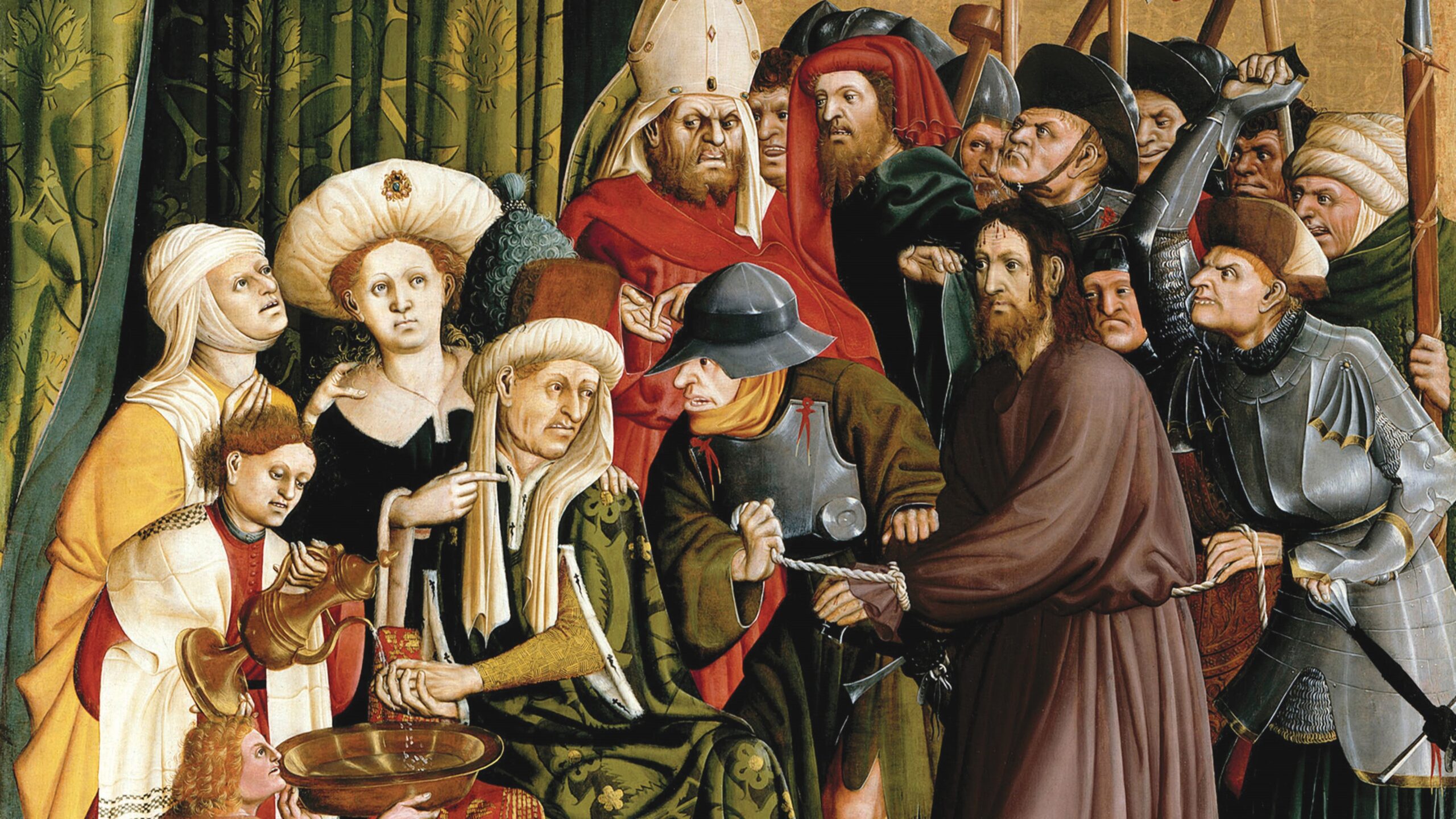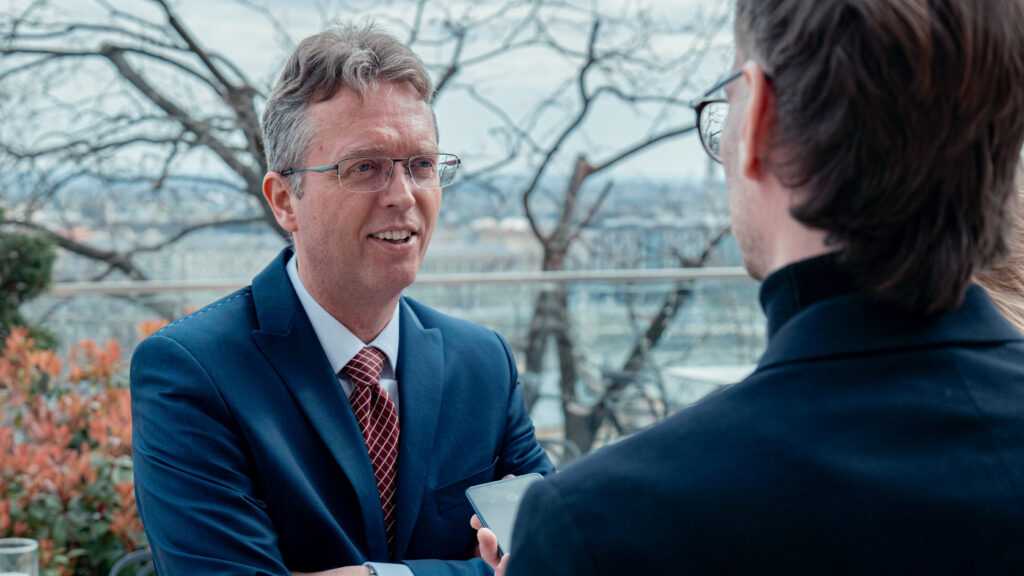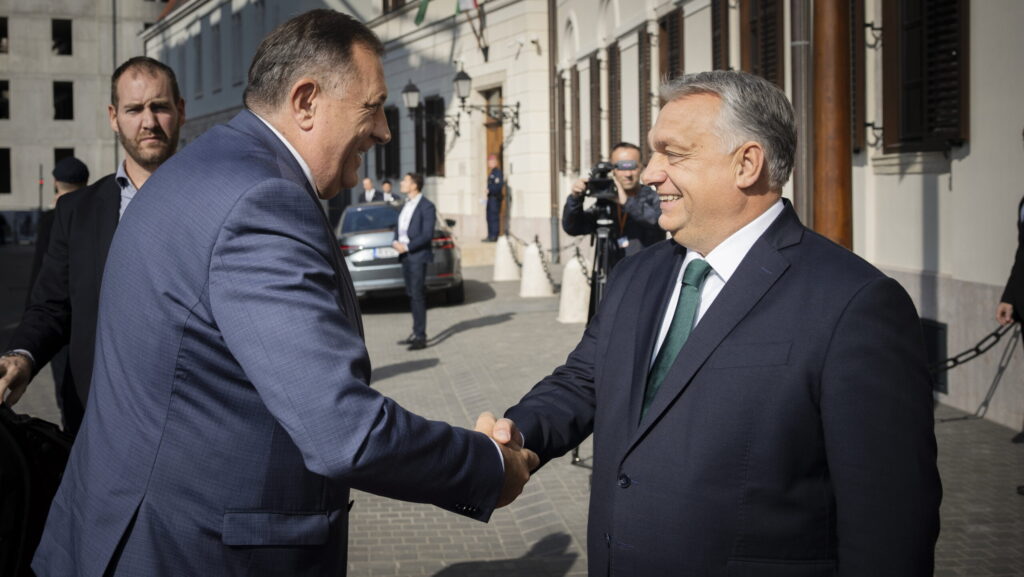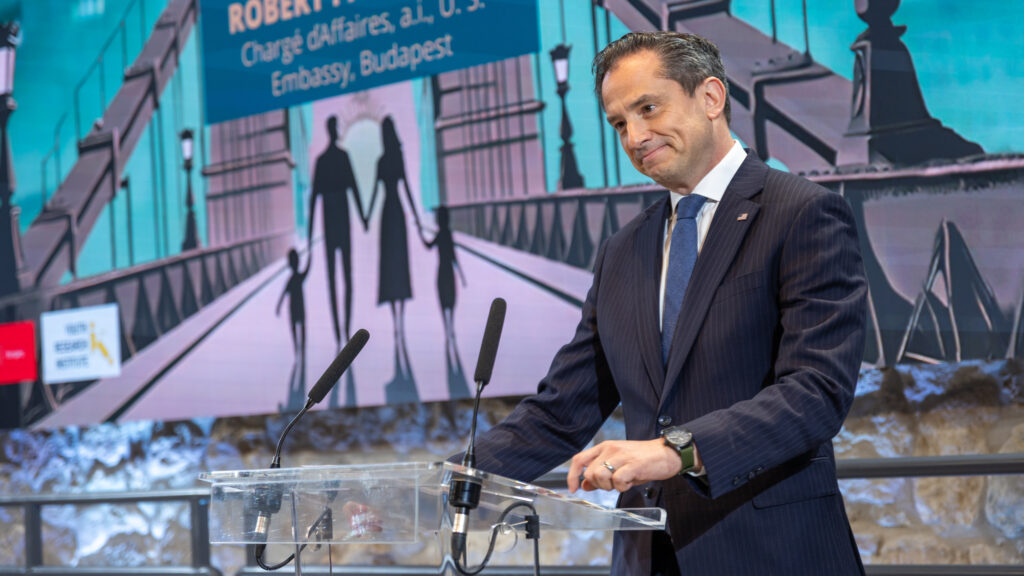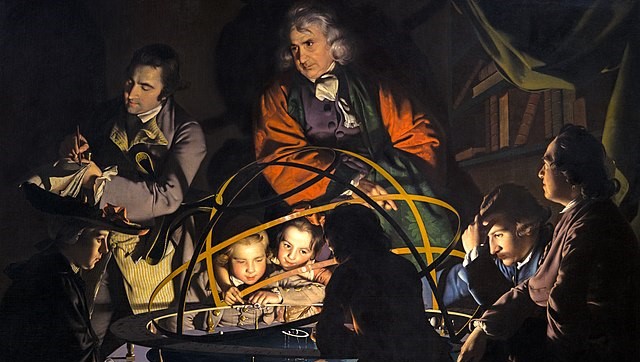This article was originally published in Vol. 4 No. 3 of our print edition.
The Foundation of Conservatism
Political thought has stakes. One either wants to say something about reality or is motivated by some other impulse; the latter is lowlier than the former. Now, if the guiding purpose of philosophy is to find and expound the truth, then the stakes involved in philosophy must be to face man as a social being and to grasp and comprehend the reality of politics. Consequently, conservatism as properly understood cannot adhere to any principle other than that of the real; it should be thought stretched between Earth and Heaven. The West feels jaded after the orgy (Baudrillard). Human experience over the motley smorgasbord of worldviews is bleak and tedious, offering no more than a sense of being full to the brim. We were to have it all, but none of it helped us. In the wake of the philosophical anarchy, Western thought is searching for a solid foothold. At this juncture, conservatism must decide whether to fall in line and become one of the available political ideologies, or reject all ideology and assume the role of mediator between the terrestrial and celestial realms, becoming a philosophy that aims to explain what happens in the world with undaunted reference to first principles. And, as we know, first principles are called first because they cannot be deduced from other tenets. We simply choose them, and we do so in an admittedly arbitrary manner.1
The Difficulties of Forming a Canon
Coming up with an authoritative definition of conservatism is not an end in itself so much as a sort of ritualistic pursuit, which we perform expecting some change from it along the lines of a deeper understanding of our past, our present, and the mysteries of the human species and the world. There are any number of ways in which the history of conservative thought could be written, if only as a story of the attempts at grasping the very notion of conservatism. Some of these attempts have been seminal, others have turned out less well. There is no shortage of synthesizing works which shy away from articulating a powerful interpretation and content themselves instead with providing the imprint of a particular era. A typical example in Hungary is the 2022 volume of essays A megőrzés parancsa (The Call to Conserve), a collection of studies by thirty-seven authors considered conservative in one sense or another by editors Máté Botos and Balázs Fekete, each discussing a book deemed to be vital. This compilation was conceived as an answer to a left-wing publication inspired by a similar concept.2
Then we have works whose editors primarily rely on the sheer taste of the authors. This may seem like an astonishing rule of thumb for compiling a book, but it can produce useful manuals, such as Zoltán Frenyó’s Konzervatív arcképek (Conservative Portraits).3 Alternatively, it can yield grotesque results, as in the case of Francesco Giubilei’s compilation, which makes room for fascists, Nazis, and other socialists.4
Finally, some publications, informed by the intent to establish a canon, strive to enforce uniform standards throughout. These feature writers whose habit of mind and political stance are not different enough to separate them from one another conclusively and beyond hope of reconciliation. Editing such works is a formidable task. It is usually preceded by years of contemplation, and they are often imprints of internal struggles and doubts. A case in point is Russel Kirk’s The Conservative Mind, which the author reworked more than once. We have several versions of the conservative canon synthesizing the criteria of belonging to the movement; Roger Scruton himself made a number of attempts at defining the essence of conservatism.
Genres of Conservatism
Conservatism may assume an imperial character, its most influential form worldwide. In this respect, British and American conservatism is much more akin to its Russian or Habsburg counterparts than to the Spanish or French varieties. (The latter two have a distinctive Catholic flavour, even though these countries, too, used to boast extensive colonies.) Conservatism can appear in a particular national guise, as in Germany and Hungary. It can be intimately tied to a certain land or province with its attendant, unique mentality—such as that of the Székelys (Seklers), the large Hungarian ethnic minority in today’s Romania—where it mainly manifests itself in ways of living, while in its abstract form, it tends to be preserved in local literature only.
Furthermore, conservatism can mean practical politics more than anything else (from Klemens Wenzel Lothar von Metternich to Jarosław Kaczyński or Viktor Orbán). Furthermore, it may be expressed in purely intellectual terms as a view of history, as is the case with Christopher Dawson.
Some conservative thinkers have apparently acquiesced to the ethos of modern times. They believe that conservatism must become an ideology—if it has not been an ideology all along. A key feature of ideologically-minded conservatism is its self-proclaimed refusal to fight realities. Conservatives of this bent not only accept as fact the modern intellectual climate and the recent developments in the realm of ideas but engage in a dialogue with them, often positively integrating their propositions. This is how conservatism becomes an ideology in the thought of Robert Nisbet, and postmodernity an inspiring partner to debate for Márton Békés. The conservatism of ideology is typically marked by its focus on the present and its allegiance with the objectives of daily politics. It tends to undervalue the role of morals in politics, foregrounding stability, and political knowledge instead (as in the work of Gábor G. Fodor).
Conservative thought (this time excluding traditionalism in the strict sense of the word) always remains open to questions. Since it is free of doctrine, (1) it remains amenable to dialogue with various traditions of thought; (2) it is willing to internalize the lessons of the recent past; and (3) it responds sensitively to current trends.
Conservatism, Tradition, and the Past
Any conservatism is always linked to some kind of tradition. The degree of this attachment varies widely. For instance, Great Britain has for centuries managed to steer clear of catastrophic collapse or state failure. While it lost its status as a global empire with the independence of its former colonies, this did not entail the collapse of its constitutional order. History in Hungary, more abundant in vicissitudes and downturns, has created another kind of conservatism, with ambitions and techniques quite different from those seen in the English-speaking world.
Governing a people in harmony with its inherent nature presupposes a profound knowledge of its history and, especially, of its recent political past and thought. In the absence of this knowledge, we cannot speak about moral imagination, which is a precondition for making the right decisions. At the same time, it is not possible to comprehend social and geopolitical trends without studying the ideas that have influenced recent political decisions. The process of facing and exploring facts must be combined with action based on understanding to attain to political realism.
Sometimes this dual vision ends in fusionism, exemplified by Frank Meyer, who sought to reconcile conservatism with liberalism. In Hungary, Békés is working to find a common ground for anti-globalist leftist thought and conservative ideals.5 Whether this rather peculiar project will come to fruition cannot be judged presently.
Conservatism and the Present Era
Reality resists human reason as we seek to understand, describe, and process it. Therefore, as Áron Czopf argues, there cannot be a single, all-encompassing, final, and simple answer to the problems of society.6 Nevertheless, the failures of liberalism and socialism do not prevent conservatives from making valid statements about reality (although adherents of the aforementioned tenets have succeeded in doing so on occasion). Yet dynamic response demands intellectual flexibility, the ability to ceaselessly adapt to the challenges and formal requirements of the present time. This is why the era of mass media saw the rise of popular conservatism (as represented, for instance, by Ben Shapiro), although this means media activism more than anything else.
‘Hungarian political thought is rooted in…the collapse of the thousand-year-old Hungarian statehood and the elimination of Hungarian national sovereignty in 1920’
It is not easy to perceive unity beyond diversity. This is because in the zone of influence dominated by English-speaking countries, to paraphrase Anthony Quinton, any clear understanding of conservative principles is hindered by the anti-theoretical habit of most conservatives.7 This claim may be intended to be universally applicable, but it is really only true for the Anglo-American brand of conservatism. By way of illustration, let us take a brief look at the ideas of a few emblematic authors toward circumscribing the notion of conservatism, or at least shedding some light on its essence. The lacklustre, bland conservatism of Michael Oakeshott hardly marks more than a kind of disposition or inclination:
‘To be conservative is to be disposed to think and behave in certain manners; it is to prefer certain kinds of conduct and certain conditions of human circumstances to others; it is to be disposed to make certain kinds of choices. And my design here is to construe this disposition as it appears in contemporary character, rather than to transpose it into the idiom of general principles…To be conservative, then, is to prefer the familiar to the unknown, to prefer the tried to the untried, fact to mystery, the actual to the possible, the limited to the unbounded, the near to the distant, the sufficient to the superabundant, the convenient to the perfect, present laughter to utopian bliss. Familiar relationships and loyalties will be preferred to the allure of more profitable attachments; to acquire and to enlarge will be less important than to keep, to cultivate and to enjoy; the grief of loss will be more acute than the excitement of novelty or promise. It is to be equal to one’s own fortune, to live at the level of one’s own means, to be content with the want of greater perfection which belongs alike to oneself and one’s circumstances.’8
Roger Scruton is extremely popular in Hungary, with translations of his works appearing even more frequently following his death in 2020. Scruton must be seen as an Englishman if there ever was one, but his affinity with Eastern Europe, his branching erudition, and his sense of isolation in the British community have particularly endeared him to his Hungarian readership. Throughout his life, he often reflected on the history of conservatism. In the introduction to Conservative Texts: An Anthology, he famously said the following: ‘If you ask a conservative for a statement of his political convictions, he may well say that he has none, and that the greatest heresy of modernity is precisely to see politics as a matter of conviction: as though one could recuperate, at the level of political purpose, the consoling certainty which was once granted by religious faith. In another sense, however, conservatism does rest in a system of belief, and is opposed to as much the theory as to the practice of socialist and liberal politics.’9
The key features of Scruton’s conservatism in his early phase can be summed up as follows: 1) Political theory should not be allowed to become ideology, which is but a substitute for religion. 2) In the conservative view, the state is only threatened by unrest as long as people look to social and political change in the hope of solving problems which by their essential nature cannot be solved. 3) The conservative considers it his foremost duty to preserve the prevailing order. He seeks the alternative to socialism in the specific realities of the existing social order, rather than in some abstract notion of freedom. 4) The way the market operates tells us important things about human nature, but the free market cannot lay exclusive claim to being the model of social cohabitation. 5) The institutions of normality, including the family and the self-regulatory system of civil society, form an integral part of tradition.
According to Scruton, the following principles have proved vital for conservative political theory: 1) civil society; 2) sovereignty; 3) representation; 4) an organic constitution; and 5) restricted government. As he explains, the major intellectual question has always been how to limit power, while retaining that inner unity of power which seems to be required by sovereignty. This criterion is augmented by 6) the prerequisite of rule of law, under which law fulfils a mediating function guaranteed by judicial independence. Scruton adds, with a sneer, that the rule of law comes with many things and it would be rather difficult to divorce it from historical circumstance.10
The Challenges of Hungarian Conservatism
The conservative tradition in Hungary is balanced quite differently, and not primarily because of the oft-cited specificities of the country’s historical experience and tradition—if only because the findings of rational philosophy concerning the nature of man and power are universal in nature. Hungarian political thought is rooted in something entirely different, namely the collapse of the thousand-year-old Hungarian statehood and the elimination of Hungarian national sovereignty in 1920.
Liberal conservatism in Hungary in the nineteenth century had a number of objectives, some of them in practice mutually contradictory: 1) the protection of Hungary’s historical constitution; 2) winning national independence; 3) the Magyarization of the entire population of the Carpathian Basin; and 4) declaring the Hungarian majority to be the repository of progress and thus of a superior way of life that must be popularized among all the peoples of the Holy Crown. The Versailles Peace Treaty (or ‘Trianon’, as typically known to Hungarians) abolished the prerequisites of this argument, altering the trajectory of conservative thought in the country. In geopolitics, Hungarian conservatives began to focus on revisionary claims, while intellectually retreating into self-defence.11 During the Second World War, Hungary was occupied by the Third Reich and then by the Soviet Union. The country was unable to even partially regain its sovereignty until 1989, when the democratic transition commenced. At that point, Hungary apparently waived its territorial claims, on the basis of two major considerations. One was obviously the lack of a powerful military ally with vested interests in resettlement. The other, more important reason was the fact that demographic trends did not support the nation’s romantic self-image.
As a result, the conservatism of the Horthy era must be seen as a historical antecedent but cannot be used as an immediate guideline for political action today. In this way, what the current right-wing administration affirms as its declared goal is not to redraw national borders but to forge a new kind of unity in Central Europe and the Balkans, with Hungary serving as the chief integrator, the pillar of stability, and the engine of progress. Yet there seems to be a disconnect between proactive politics and theoretical endeavour: Intellectual responses in public affairs seem to have been stuck in a defensive rut.
Wellsprings of Hungarian Conservatism
Intellectual conservatism in Hungary typically relies on three major sources: traditionalism, the philosophical tradition of natural rights, and the biblical-theological tradition. Every conservative publication draws on one or another of these three arsenals, mostly in some kind of combination. Although it is rare for an author to have recourse to one of them exclusively, some characteristically prefer one over the other two. For instance, Imre Tibor Baranyi’s work is firmly rooted in traditionalism, András Lánczi chiefly argues along the lines of natural rights, while Balázs Mezei’s thought is nourished predominantly by the philosophy of religion. Thomas Molnar was a Catholic traditionalist, Zoltán Turgonyi a Catholic scholar of natural rights, and Gergely Szilvay built on all three intellectual foundations simultaneously.
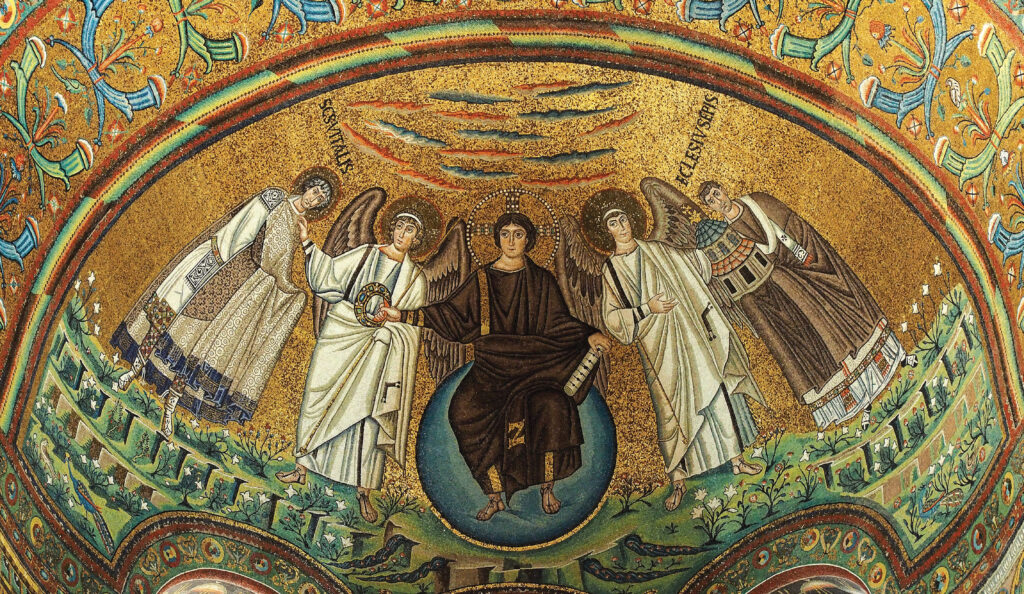
The Radical Conservatism of Zoltán Frenyó
Zoltán Frenyó is convinced that Europe is at an epochal crossroads today12 and is undergoing the greatest intellectual crisis in centuries. He praises Antonio Salazar, who describes the intellectual history of recent centuries as a record of the insanity of philosophy. This frenzy has ‘conquered great minds by undermining their insistence on eternal verities, and eroded all the great certainties… They came to repudiate God, certainty, truth, justice, and morality… We attempted to restore the solace of the great certainties to the souls that have been torn by doubts sown by the negativism of the century. We did not debate over God and virtue; we did not question country or history; we did not question authority and its worth; we did not question family or its morals; we did not question the dignity of work or the duty of industry.’13
The affinity with Salazar is hardly accidental for Frenyó, who believes that the above diagnosis cries out for social activism. This is precisely why he rushes to the defence of ideology, distancing himself from Russell Kirk’s distaste for the concept and giving this rather loaded term a significant interpretive twist. Frenyó asserts that the moment an idea surfaces in society, it inevitably becomes ideology.14 He hastens to add that ideology is not an inherently unwelcome phenomenon as such, as long as it is perceived as forming a vital bridge between idea and practice. He detests the type of conservatism that shrinks from the concept of ideology as a purported nest of infertility. By contrast, he sees ideology as a politically organized set of views necessary for the idea itself to be manifested effectively in the social sphere. An author is often betrayed by whom or what he ultimately regards as the opponent, or even foe, of conservatism. Frenyó sets his aim at liberalism as the enemy to fight. In the hope of victory, he does not stop short of promoting to the conservative canon certain advocates of Christian socialism and corporatism, on the grounds that, during the unfolding and destructive maturity of predatory capitalism, thinkers such as Ketteler, La Tour du Pin, de Mun, Messner, and Oswald von Nell-Breuning really worked to halt the dissolution of Europe’s intellectual and social order.
To put it differently, Frenyó seems to say that the Catholic Christian socialists and the corporatists are separated from the conservatives only superficially, by an optical illusion caused by the false liberal vision of politics. Monarchy and republic, democracy and autocracy are not really opposites; any antagonism between them only seems real from the perspective of liberalism. But what makes it so difficult for conservatism to define itself? First of all, it is the fact that, at its inception, it assumed the role of preserving the pre-political social order. However, if what we want to preserve is not the status quo but normality, in other words the requisites of a life of dignity in society, then conservatism cannot afford to revert to the times and forms predating the triumph of liberalism. Faced with the menace of destructive ideas, it must remain open to any solution if it aids the survival of conditions that make human life worth living. In short, Frenyó’s argument is consistent within the terms of his own system. The raison d’être of ideology is justified by the very call to create a mass movement if nothing else—an observation he supports with reference to Ottokár Prohászka.15 At the same time, Frenyó’s anti-capitalist stance remains in evidence throughout:
‘Apart from its self-abnegating, opportunist variety always ready to bargain with capitalism, all brands and periods of conservatism share the same system of norms, which provides them with better cohesion than any tactical considerations of methodology concerning reform or revolution that may divide them. These are not absolute principles so much as historically defined solutions that appear expedient or even outdated. Therefore, the essence of conservatism is broad enough to encompass anything from prudent reform to a coup d’état, as the case may be. Some accounts fail to consider the possibility of a conservative revolution. In these cases, the author simply regards moderate conservatism as virtually the only feasible form of conservatism. This is a rather snug view that threatens to defang conservatism itself.’16
Catholic political thinking can unfold according to an entirely different mindset. Balázs Mezei, for instance, explores the phenomenon of conservatism in the abstract, from the vantage point of the philosophy of religion.17 He distinguishes between four fundamental approaches, including the traditionalist, the conservative, the liberal, and the anarchist. It is important to point out that these categories are not intended as a classification of movements in the history of ideas so much as to denote eternal archetypes. As archetypes, nevertheless, they coordinate concrete historical and intellectual developments. These archetypes are distinct from one another in several ways: 1) in the relation between the finite and the infinite; 2) in the temporal dimension; and 3) in respect of fullness, i.e. their potential of organic integration with reality. Next, 4) Mezei enumerates examples from the history of ideas and politics, then 5) examines each archetype in terms of their anthropological features. His findings can be summarized as follows.
Traditionalist thought views the finite as being completely isolated from the infinite. The free, even arbitrary revelation of the infinite is the sole source of reference we can adhere to, in thought as in action. This self-revelation occurred at a specific point in the past, and is the event that must be followed at all times if we are to preserve the soundness of our thinking and conduct. Consequently, of the concatenation of past, present, and future dimensions, the traditionalist regards only the past as an authoritative guide—ultimately the past when the original, primordial divine message was first communicated to man. He sees the present and the future as instruments of faithfully perpetuating, obeying, and enforcing adherence to the heritage of this past, both mentally and in practice.
The traditionalist holds that man’s intellectual faculty is of a passive, receptive nature. Its skills are mostly limited to deductive comprehension; it is hardly capable of radically new findings of its own. The human mind operates merely as ratio, confined to consecutive reasoning, inference, and interpretation. The traditionalist places the overall emphasis on the past, primordial knowledge, sacred texts, hierarchy, law-abidance, and strict order. Considering its historical forms, traditionalist thought systems and communities include Hinduism, Islam, Orthodox Christianity, Orthodox Judaism, and ultraconservative groups, such as the Amish. Mezei considers metaphysical traditionalism to be a philosophical version of traditionalism.
The conservative stance differs significantly from pure traditionalism proper. It sees the finite and the infinite as intimately related, and this is what differentiates it from all the other approaches under discussion. This relation can never exhaust the infinite, which not only transcends the finite but also stands external to it. The source of the principle is the infinite, which can be accessed from a position in the past, the present, or the future alike, but this access remains invariably subject to imperfection. Being aware of this necessary imperfection, the conservative man always respects the limits of his self, in both thought and action.
Both intellectually and in his conduct, the conservative conceives of past, present, and future in their organic connectedness as a process of constant preservation and rebirth and of self-fulfilling comprehension. He will not rule out the ultimate form of organic renewal in which it becomes possible to understand past and present and apply the lessons of this understanding in practice, even though he realizes that any such application must remain ambivalent due to its finite nature. All things considered, then, he places the emphasis on organic relationships and the wholeness of the intellect. Everything may be correlated with anything, but this correlation itself is subject to the ultimate source, which cannot be appropriated since everything that exists is but a function of this source. As examples of the archetype of conservative thought that have evolved to date, Mezei mentions Roman Catholicism, original Lutheranism, Anglicanism, and, in other religious traditions, Hasidism and the Sunnahsunnitism.
Conservative anthropology regards man’s intellectual faculty as being both active and passive. Each act of reception is at once a new understanding. This is essentially performed by the active intellect, but this intellect only operates properly when it seeks to explore the intellectual realm of God. This faculty of intellectus, however, goes strictly hand-in-hand with ratio.
The liberal, by contrast, tends to blur the distinction between the finite and the infinite, as two overlapping qualities. For him, finite understanding has an infinite validity, intellectually just as in practice, obviating the need for self-imposed limits. The liberal sees the relationship between past, present, and future as an antagonistic one, in which the present negates the past, and the future repudiates the past and the present. He sets the goal of abolishing the past and to create a present that doubles as the future. The overall stress, then, is on the negation of what has been, on self-assertion, and on orientation towards the future—the utopia within reach. Mezei says that the historical formations of the typical liberal mindset, characterized by its penchant for ignoring temporal planes, are best exemplified by the radical Protestant and Neo-Protestant movements. If viewed from the perspective of the philosophy of religion, the list will even extend to various incarnations of the socialist idea, from Italian socialism, fascism, and national socialism. He even mentions ‘Christian democracy’, Freemasonry, and Zionism as prone to arbitrarily cherry-picking and adopting certain elements of the Christian heritage, Mezei’s own tradition.
In the liberal assessment, once again, the human mind has both passive and active aspects, but the latter is predominant across the board. While ratio is important, the decisive faculty is that of the intellectus, as in German Vernunft (as opposed to Verstand). This implies the ability to create entirely new things freely, even at the expense of overwriting the Divine intellect.
Finally, the anarchist labours to eliminate the very categories of the finite and the infinite. He holds that the only thing to consider, in thought as in action, is the impulse of the moment. Not only is it the case that everything is permitted and everything is possible, but everything must be of necessity rejected and made anew. The anarchist dispenses altogether with the tripartite view of time as consisting of past, present, and future, and will not recognize any principle, rule or guidance of thinking and conduct. Anarchism in its essence equals total negation, the only positive exception being the momentary impulse, which cannot be regulated. The historical manifestations of anarchism include sectarian millenarianism, Woke, the green movements, and satanist groups. The anarchist is without hope: He inhabits a relentless intellectual void, in which he must think and act as dictated by his understanding of the fleeting moment—and this is what he expects others to do as well. If he has recourse to anything that could be called faculty, it is a form of intuition that is altogether beyond the reach of any control or regulation.
Balázs Mezei’s Conclusion
The various approaches of traditionalism, conservatism, liberalism, and anarchism form a single conglomerate with its own history and dynamics. This was described by Plato in his own way in respect of the necessary alternation between different forms of government. This process, in Plato’s view, inevitably leads to anarchistic tyranny, to be followed in turn by complete renewal. Each type at once embodies a type of human being, a form of government, a historical period, and a given state of the world. Reality is the sum total of all these things, and this whole is more than the sum of its parts. This sum is the basis of what Mezei calls holistic conservatism, a conservatism that offers not only a panorama of archetypes and their historical instantiations, but also an understanding of the importance of this whole in itself. This whole, according to Mezei, is the absolute, i.e., God, thus holistic conservatism is at the same time theological.
The Final Tally
Western Christianity has sanctified everything in the spirit of Thessalonians 5:21 (‘Prove all things; hold fast that which is good’): it examined all things and preserved what it has deemed worth preserving. This is how Platonism and Aristotelianism not only found their way into Christianity but carved out a niche as the two decisive trends in Western thought, adamantly opposed to any version of anti-philosophy (the sophists, the occultists, Marx, Freud, the syncretists, and the postmodernists—all propagating a hatred for the love of wisdom). Seen in this light, what is conservatism like at present? And what kind of future can we envision for it?
1) Conservatism proceeds by the method of cancelling while preserving. Any political action in the name of conservatism will depend on the era, on the current situation, and on sheer opportunity, but it can never come to fruition unless it has a solid foundation to fall back upon. But whence the need for this apparently circuitous definition? It is in the interest of endurance. Ideology is very much a human thing, and as such, it is inevitably subject to specific circumstances and interests. Because it always remains amenable to being edited and rewritten, it is pregnant with danger and must therefore be shunned.
2) Conservatism as a political system has the power of integration and assimilation.
3) Christianity, the ultimate source of our morality, cannot be rewritten (with impunity). It follows that, in Western culture at least, no government can simultaneously possess the following attributes, unless it is conceived in the spirit of the teaching of Christ: a) It will not hinder the salvation of its citizens, because it will not allow evil to manifest itself (if this can be helped). To do this, we must have unambiguous ideas of right and wrong, acquired from the tenets of our faith. b) It ensures legal order, based on the teachings of Christianity. c) It is capable of long-term survival without oppressing the people. Christian philosophy specifies clear-cut criteria for a system of government to be regarded as tyranny.
So what is the true path of conservatism today? The answer to this question is simple: Conservatism is but the political form of Christianity.18
Translated by Péter Balikó Lengyel
NOTES
1 This article is an edited version of my essay entitled A konzervativizmus ötven árnyalata (‘Fifty Shades of Conservatism’), first published as part of a volume of studies in a doctoral program sponsored by the Batthyány Lajos Alapítvány, 2022/2023, 356–367.
2 Balázs Böcskei, and Miklós Sebők, eds, 50 könyv, amit minden baloldalinak ismernie kell (Fifty Books that Left-Wingers Should Know) (Kossuth Kiadó, 2015).
3 Zoltán Frenyó, Konzervatív arcképek (Conservative Portraits) (L’Harmattan, 2021).
4 Francesco Giubilei, A nyugati konzervatív gondolkodás kézikönyve (Handbook of Western Conservative Thought) (Ludovika Egyetemi Kiadó, 2021). For more details, cf. Miklós Pogrányi Lovas, ‘A konzervativizmus nyomában’ (On the Trail of Conservatism), Kommentár, 4 (2022).
5 As part of this thought experiment, Békés sometimes attempts to elevate into the conservative canon authors of such diverse convictions as the enlightened Rousseau, the Marxist Gramsci, or the syndicalist Georges Sorel. Cf. ‘Rousseau és a nemliberális demokrácia’ (Rousseau and Illiberal Democracy), Kommentár, 3 (2019); ‘Új jobboldal’ (The New Right), Kommentár, 1 (2019); ‘A politikai erőszakról. I. rész’ (On Political Violence, Part I), Kommentár, 2 (2017).
6 Áron Czopf, ‘Difficulties of Critiques of Modernity’, Hungarian Conservative (28 December 2022).
7 The author defines the essence of conservatism around three principles. In Hungarian translation: A tökéletlenség politikája (The Politics of Imperfection) (Pécs: Tanulmány Kiadó, 1995), 14–20. Quoted in: Zoltán Frenyó, ‘Előszó’ (Preface), Konzervatív Arcképek.
8 See: Michael Oakeshott, ‘On Being Conservative’ (1956), https://wp.aleteia.org/wp-content/uploads/sites/2/2014/02/on_being_conservative.pdf, accessed 3 May 2024. In Hungarian translation: Michael Oakeshott, ‘Konzervatívnak lenni’, Holmi, 4 (2000).
9 Roger Scruton, Conservative Texts: An Anthology (Macmillan, 1991).
10 In his work cited here, Scruton also mentions human rights, although he clearly dismisses arguments trying to justify them on the grounds of natural rights.
11 Hungarian conservatism between the two world wars relied on Catholic teachings about society as its main source of inspiration. During this period, the most heavily represented trend was corporatism, in both its hardline and milder forms. Political practice was comparable to the corporatist routines followed by countries such as Austria, Spain, and Portugal. Cf. Miklós Pogrányi Lovas, ‘Sziklán állunk’ (We Stand Upon a Rock), Kommentár 2 (2022).
12 Zoltán Frenyó, Korfordulón (At a Turning Point) (MTA, 2016).
13 Translated into English from the Hungarian translation: António de Oliveira Salazar, Békés forradalom (Peaceful Revolution) (Athenaeum, n. y. [1942?], 219–220, 296.
14 Frenyó, Konzervatív arcképek, 10.
15 Cf. Ottokár Prohászka, Kultúra és terror (Culture and Terror), chapter on ‘Lelki kultúra és tömegmozgalom’ (Intellectual Culture and the Mass Movement) (Élet, 1918), 17–19; Ottokár Prohászka, Összegyűjtött Munkái. Vol. 11. (Szent István Társulat), 1927, 242–243. Quoted in Frenyó, Konzervatív arcképek.
16 Frenyó, Konzervatív arcképek, 18.
17 Professor Mezei made available to me one of his writings still in manuscript form. Hereinafter I refer to this work as the Mezei MS, 2023.
18 For an in-depth articulation of this idea, cf. Miklós Pogrányi Lovas, ‘Európa – Élet vagy halál’ (Europe: Life or Death), Kommentár, 3 (2020); and Miklós Pogrányi Lovas, ‘Jobboldali törzsszövetség’ (Right-Wing Tribal Alliance), Kommentár, 2 (2020).

